High Detail Gaming and 3DMark
We also ran several of the games at higher detail settings to put more of a load on the graphics cards. Not surprisingly, performance sometimes becomes unacceptable at higher resolutions and detail settings with these laptops, depending on the game. The GeForce 9800M GTS and 8800M GTX may be some of the fastest mobile graphics chips currently available, but they're both still slower than a single desktop 8800 GT 512MB because of the more stringent power requirements. We'll also include 3DMark results here for reference; we put a lot more stock in gaming performance than in 3DMark results, but at least 3DMark results are easily generated and easily compared.

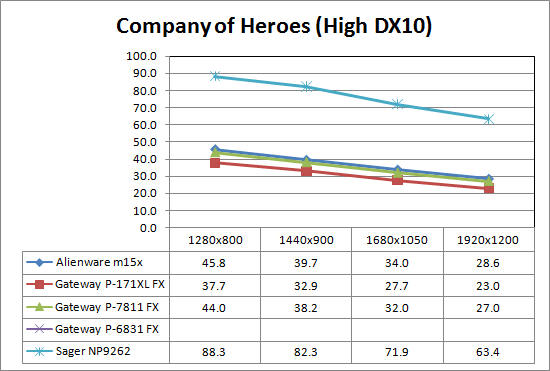
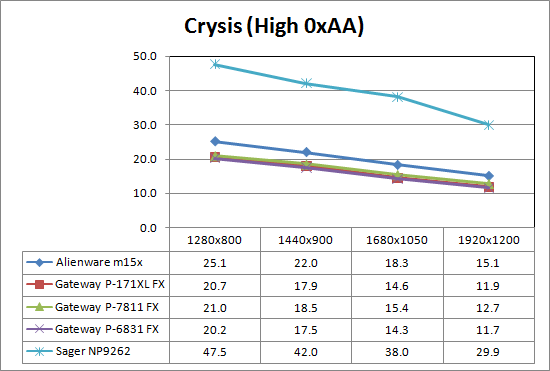
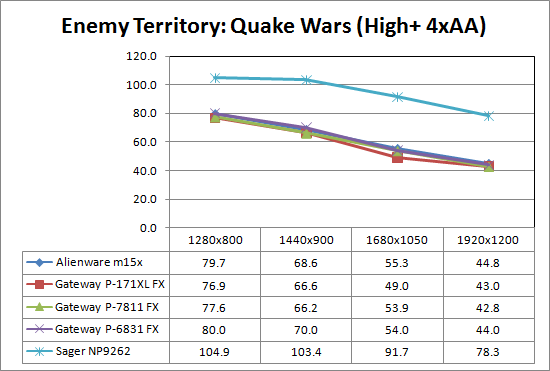

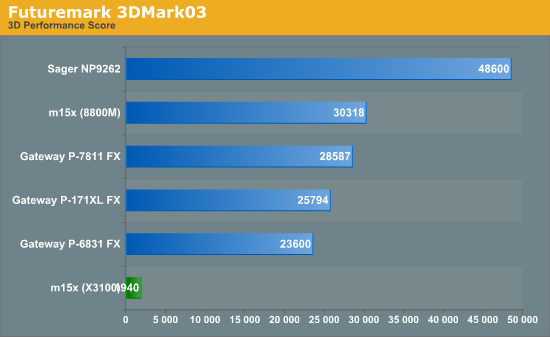
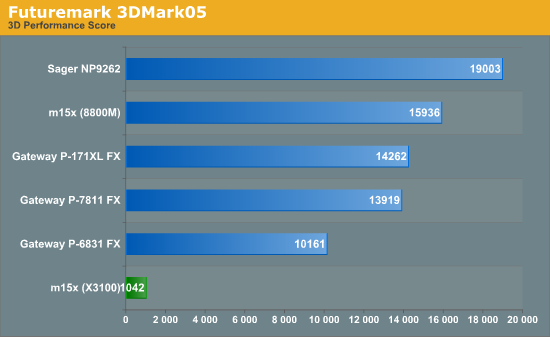
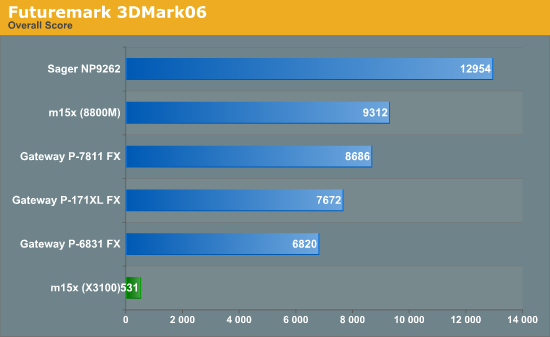
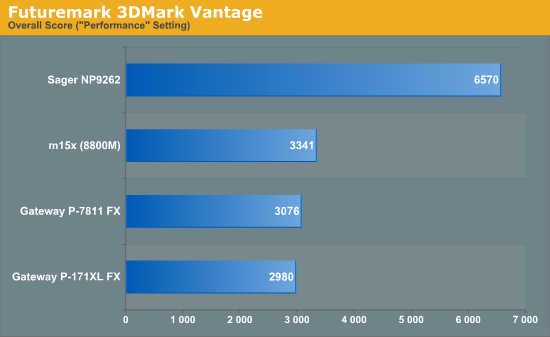
The patterns on the previous page are continued for the most part, with a couple items that bear mention. First, Assassin's Creed DX10 is faster than the DX9 version on the Sager NP9262, so there's at least some small driver glitch with the tested NVIDIA SLI drivers. You can also see that several of the games are all but unplayable on everything but the Sager NP9262, particularly at 1920x1200. It's interesting that the Sager is still CPU limited in quite a few situations, so the faster models that are now shipping will benefit from the CPU upgrade.
Looking at the 3DMark results (and then hurriedly moving on), most of the charts are similar to the gaming results. The integrated graphics on the Alienware m15x are clearly not for gaming, with performance that's about 5% of the slowest of the gaming laptops. It also is unable to run in 3DMark Vantage, since it lacks DX10 support. While you definitely won't want to do serious gaming using the X3100, we will see in a moment how useful it is when we get to the battery life tests.
As a final summary of gaming performance, we offer the following table comparing relative performance between the various graphics solutions at 1920x1200. While CPU and platform will still have a small impact, in most cases the GPU(s) are what will determine frame rates at higher resolutions.
| Performance Relative to GeForce 8800M GTS (Gateway P-171XL) | ||||
| Gateway P-171XL FX | Gateway P-7811 FX | Alienware m15x | Sager NP9262 | |
| Assassin's Creed DX9 | 100.0% | 119.9% | 124.2% | 150.3% |
| Assassin's Creed DX10 | 100.0% | 103.9% | 116.5% | 226.0% |
| Company of Heroes DX9 | 100.0% | 118.4% | 132.5% | 255.7% |
| Company of Heroes DX10 | 100.0% | 117.4% | 124.3% | 275.7% |
| Crysis - Medium | 100.0% | 103.1% | 123.7% | 261.2% |
| Crysis - High | 100.0% | 106.7% | 126.9% | 251.3% |
| Devil May Cry 4 | 100.0% | 155.0% | 163.5% | 177.2% |
| ET Quake Wars 0xAA | 100.0% | 100.3% | 108.6% | 167.5% |
| ET Quake Wars 4xAA | 100.0% | 99.5% | 104.2% | 182.1% |
| Race Driver: GRID 0xAA | 100.0% | 122.4% | 127.3% | 205.9% |
| Race Driver: GRID 4xAA | 100.0% | 118.1% | 120.2% | 227.0% |
| Mass Effect | 100.0% | 114.2% | 120.2% | 190.4% |
| Oblivion | 100.0% | 124.3% | 129.7% | 236.9% |
| Unreal Tournament 3 | 100.0% | 128.9% | 126.9% | 195.7% |
| Average All Games | 100.0% | 116.6% | 124.9% | 214.5% |
| Average for HQ Settings | 100.0% | 112.0% | 120.3% | 227.0% |










36 Comments
View All Comments
Th3G4mbl3r - Saturday, August 30, 2008 - link
can you also laptop from killernotebook.com into the review as well? they are similar to the sager systems in the sense that they are also custom built based on ODM chassis by Mark from killernotebook. I am keen on looking at some head on comparisons for those with the rest of the field.JarredWalton - Sunday, August 31, 2008 - link
It's difficult to properly evaluate service and support, but since all three companies offer the same Clevo D901C notebook seen in this review, consider this configuration:1920x1200
Q9550
2x9800M GT
2x2GB RAM
3x320GB HDD in RAID 5
Blu-ray Recorder
3-year Warranty
Sager NP9262: $4538.00
AVADirect D901C: $4659
Killer Notebooks Odachi: $5174
There's no ability to select a warranty at KillerNotebooks.com (it's 1-year according to the "About Us" page), and the site layout does not instill confidence. The support section doesn't even list 8800M or 9800M drivers for the Odachi (apparently misspelled "Odach" in various locations). I'm definitely not going to recommend spending $500 or $600 more to get the same notebook with a lesser warranty.
SpacePope - Saturday, August 30, 2008 - link
Thanks for the review, this is a good start. I've been researching gaming laptops myself lately because I plan on buying one soon. From what I've seen so far, the Asus G50V-A2 seems to have the most bang for the buck. Can you add this laptop to the review?Core 2 Duo T9400 2.53Ghz
15.4" WSXGA+ (1680 x 1050)
4GB DDR2
2 x 7200rpm 200GB HD in raid
Blu-ray drive
NVIDIA GeForce 9700M GT (512MB VRAM DDR3)
All for only $1899 on newegg (and I'm sure you can find it on sale somewhere).
Personally, I think alienware is VERY over priced and a horrible value. They even use slower 667Mhz ram and last generation video cards. I've never heard anything good about their customer service. You can easily spend $1000 more on the alienware and get a worse laptop than the Asus. The gateway's are a good deal (and tempting) but I want a 15.4" screen, not 17". Finally, I don't know or trust Sager yet.
JarredWalton - Saturday, August 30, 2008 - link
I've requested a couple ASUS laptops, so we'll see. Outside of the 15.4" part, I'd rate the Gateway higher in every area. However, form factor is a pretty major consideration. I expect the 9700M GT will be around 65-75% of the performance of the P-7811, so with a lower maximum resolution it should run pretty well.As for Sager, they have been selling laptops (with a moderate focus on enthusiast models) for over 20 years - since 1985. I would have no problem recommending them as a company. As such, the NP2096 is one option (15.4" 1680x1050, 9600M GT, P9500 CPU, 4GB RAM, and 320GB HDD for ~$1550). For more gaming performance, check out the NP8660. It's more expensive than the ASUS, the the 9800M GT is about twice as fast as the 9700M GT I'd guess. It actually looks quite similar to the m15x in terms of specs, for a lot less money. $2300 for a nearly top-end config. Too bad there's no Smart Bay battery, and I don't know if you can disable the discrete GPU.
Voldenuit - Friday, August 29, 2008 - link
" this is the first laptop we've tested that includes the option to shut off the discrete graphics and use integrated graphics."Cough. A bit behind the times on laptops, are we? Several Asus and Sony models have featured this already, going back as far as 2 years ago.
The Montevina refresh to the thinkpad T series (T400, T500) allow you to switch between integrated and discrete (Radeon 36xx) graphics on-the-fly in Vista. Now we're talkin'!
JarredWalton - Friday, August 29, 2008 - link
"first laptop we've tested" says it all. I know perfectly well that others have done it, and I mention (repeatedly) that the Centrino 2 offerings are supposed to improve that functionality. Now I just need to get the appropriate companies to send laptops for review, which is always the difficult part. Still, the feature is far more useful IMO when you're using it with high-end GPUs. Switching between 8400M and IGP isn't as critical as switching between 8800M/9800M and IGP.Jumpman23 - Friday, August 29, 2008 - link
Another great "budget" gaming laptop would be the Asus G50V. The specs show the price to performance ratio is very good and comes equipped with 9700M GT. I would love to see a review on it.yyrkoon - Friday, August 29, 2008 - link
I would like to mention that the Sager seems to use close to what A 'medium power' Desktop would use for power consumption(minus the monitor). That is *if* these figures you're showing are accurate compared to my readings (or vice versa).Let me define a 'medium power' desktop system:
ABIT IP35-E
Intel E6550 @ 2.8Ghz
2x2GB A-DATA 1.8v DDR2-800
eVGA 9600GT 512MB
1x DVD/CD burner(Liteon if applicable)
4x HDDs (all Seagate if applicable)
Antec Earthwatts 500
Again, to be fair, what I measured was just the hardware in the case, so there are no LCD/CRT monitor figures counted in. At idle the above system uses 124-125W. while web surfing and doing other non intensive tasks the system above uses 128W-135W. With a full load on the CPU using orthos for an hour with 2 threads running(100% CPU load), this system uses 171-174W. In World of conflict, using the in game benchmark with everything maxed(no AA or AF) this machine has peaked up to 215W. Running the same benchmark with the game output limited to 30FPS uses only 195W peak, but mostly between 185-190W.
World in conflict I have noticed so far can use by far the most power while gaming. Games such as Hellgate: London, and FEAR use around 180-195W(everything maxed).
As a kind of interesting side comparison I checked the older card I used before the 9600 GT (eVGA 7600 GT KO edition) peak idle was 106w, while peak gaming was 168W. Much lower than I had anticipated. Granted the 9600GT is also lower in power usage than I had originally thought based on reviews, and about twice as fast as the 7600 GT in most games.
Now I am very interested in how much power the new Intel mini ITX board, with x4500HD graphics and a reasonably powered desktop CPU would use. You hearing me Jarred? Derrick ? Anand ?! Would be nice if you guys could find out for all of us ; ) Something tells me that it'll only be marginally lower in power consumption though . . .
yyrkoon - Friday, August 29, 2008 - link
Monitor I use is a 19" widescreen LCD. Native resolution of 1440x900, so that is the resolution I tend to play games in. All of my figures are based on a 1440x900 resolution(for what it is worth).JarredWalton - Friday, August 29, 2008 - link
I think Gary will have an X4500 article up next week. Don't quote me on that, as I know Gary and Anand have run into quite a few issues with the G45 testing, but it's not for lack of trying.As for power requirements, I figure the LCD is using between 10W and 20W of power, and while it might be using as much power as your midrange desktop, it also happens to be faster. You'd need 9600 GT SLI at the very least (~equal performance), or 8800 GT SLI (faster performance).
The other item that we don't know is power supply/power brick efficiency. If they're both 80% efficient, that's one thing, but if the laptop is 70% efficient and your desktop is 80% efficient, that could account for another 20W or so. Anyway, since this *is* a desktop replacement, it's not too surprising that the power requirements extend into desktop territory.